You should upgrade or use an alternative browser.
- Thread starter Bill VA
- Start date
Roger Tomfohrde
Member
showcrop
Well-known Member
(quoted from post at 18:39:37 01/25/22) no difference in what your talking about. it just that a wide front is more stable. now the action will begin. had this argument before here.
Rustred, try going back and reading the OP again.
Janicholson
Well-known Member
Stability, of either, is strictly within the sanity and experience of the operator on hills at higher speeds, and with a loader in a higher than the crankshaft position. If a wide front has spring loaded down pressure on the axle pivot (new tractors and European models may) It will be the most stable. The normal free pivot wide front will tip until the axle hits the bolster or travel stop. This is a freedom to pivot that can go easily beyond the recovery possibility and tip over. Jim
redforlife
Well-known Member
Being fixed or not would be the only difference. And not fixed would be better. Otherwise the possibility is there for entire weight being only on one wheel.
the castings and screws that hold the pedestal to the frame rails or front of the engine.
Screws break or pull out. Holes get wallowed out. Wide fronts usually have a wishbone
that braces the axle if it hits a dead furrow or woodchuck hole.
(quoted from post at 20:13:13 01/25/22) No difference if both front ends are fixed. But, I will say this. A wide front end that swivels (one front wheel goes up when the other goes down), shouldn't be compared to a narrow front that is fixed and doesn't do that. Because, it's just not the same. Not sure if your familiar with a roll-amatic front end. They allowed for some movement to keep the weight equally on both wheels. Without it, the front end is just fixed other than turning. Well, a wide front that swivels gives you the same affect as a roll-amatic narrow front.
Being fixed or not would be the only difference. And not fixed would be better. Otherwise the possibility is there for entire weight being only on one wheel.
For rollover, major difference is height of tipping point.
Rollomatic pivots at ground level, so tractor stands on a triangle formed by rear wheels and narrow front and at ground level. Anytime the weight direction moves outside the triangle, tractor tips over. Shift of weight direction can be due to a slope, ateral acceleration and braking. Front loader make it very easy to do, because weight is shifted to the front and higher, so a small angle can make the weight go out of the safety triangle.
On a wide front, tractor stands on a triangle formed by the rear wheel and the front axle pivot. Only the rear edge of the triangle is on the ground.
The higher the pivot, the better.
This post was edited by fdt860 on 01/25/2022 at 08:52 pm.
IMHO the tire spacing and ballast on the rear axle contribute far more to tractor stability than whatever type of front end is used. If one rear tire is off the ground far enough that the front axle is against its stop, the tractor is already well on the way to tipping over and the front end isn't going to stop it from going over.
the tractor vet
Well-known Member
Traditional Farmer
Well-known Member
- Location
- Virginia
jon f mn
Well-known Member
caterpillar guy
Well-known Member
Geo-TH,In
Well-known Member
Dad had a 1940s farmall H, narrow front end, pipe loader with trip bucket.
The Farmall has no frame. The engine, bell housing, transmission and rear end was the frame.
The front end was stronger than the bell housing. The loader cracked the bell housing, not the front end.
So you are asking about tractors that are over 50 years old.
Not sure how much a 50 year old loader could lift.
The Farmall H was one step better than a shovel, but not that much better.
The problem with all loaders is the front wheels getting stuck in the mud and armstrong power steering.
Traditional Farmer
Well-known Member
- Location
- Virginia
Geo-TH,In
Well-known Member
Your tractors may lift more.
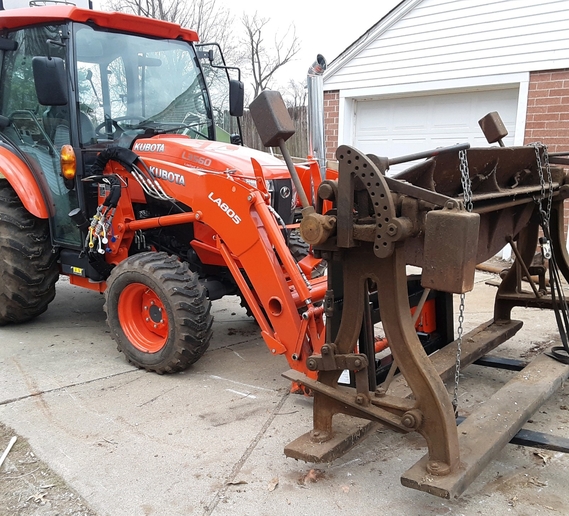
I tried lifting this old metal brake and flattened the front
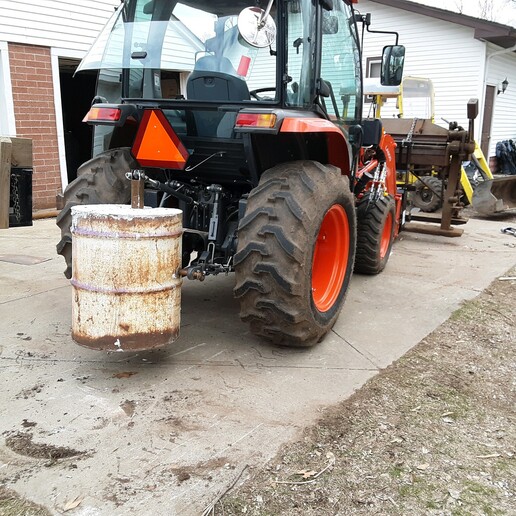
tires. I added more air and then attached a 900# rear ballast.
I'll bet you that if I damaged my front axle it would cost me more to repair, 4x4.
I have no clue what my Kubota can lift. I know if I try to lift too much dirt in the front bucket, the Kubota's computer won't let me. It just stops before there is any damage to cylinders or the front end. I like that more than winning a contest for your max weight lifting contest.
Having problems posting pics.
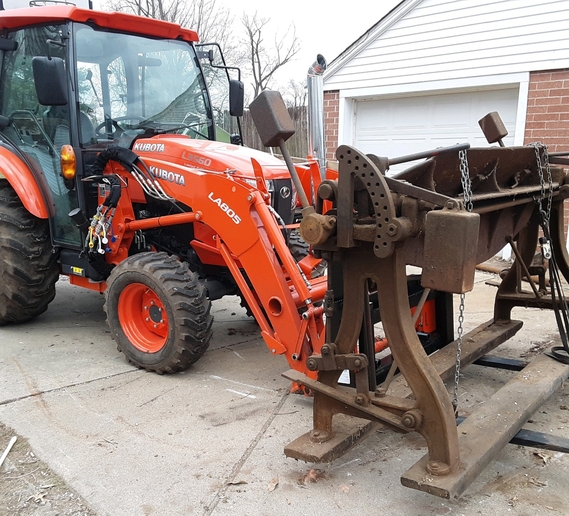
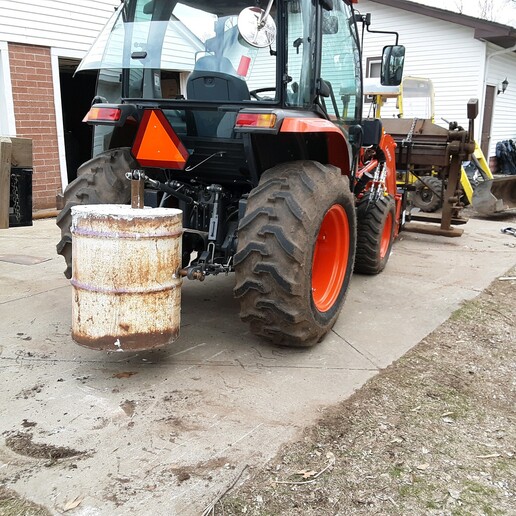
BarnyardEngineering
Well-known Member
- Location
- Rochester, NY
Most tractors were not designed for loader work.
A narrow front puts all the stress on the steering gearbox. A wide front distributes that stress to the frame of the tractor, leaving virtually no stress on the steering gearbox. All the steering gearbox has to do is turn the wheels at that point. It's not supporting any weight or experiencing any side loads.
The wide front SHOULD be stronger, as far as the mount to the tractor is concerned.
rustyfarmall
Well-known Member
The beauty of a wide front under a loader is that you can install bigger, wider front tires for more flotation. Other than that, there is no advantage.
Traditional Farmer
Well-known Member
- Location
- Virginia
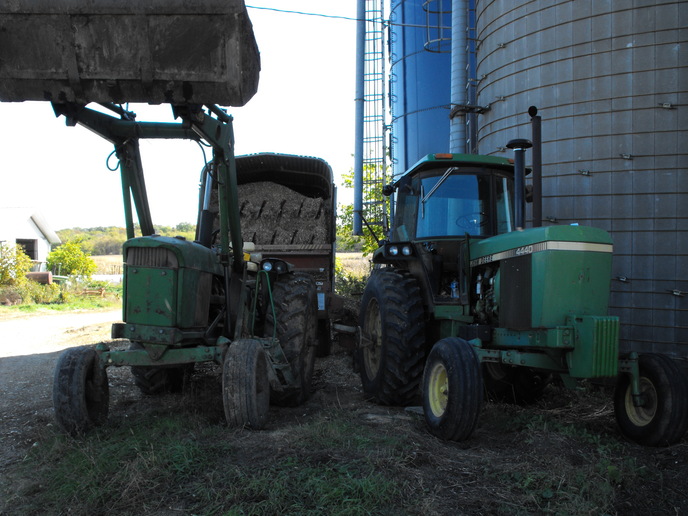
lugnuts2030
Member
tractorguy2
Well-known Member
In the 70's and 80's the Farmall M was the most common loader tractor here. We had a 48nf with a dual 325 loader. Never had any problems. I know a few farmers that broke a spindle on wide front M's when they drove into a hole.
Few years back Abilene Machine sold a kit to put a Case 1070 axle under the John deere 4020. Kit came with a green painted Case axle. Later they made a kit with a 4630 axle. The Case axle fit better under the 4020 than the 4630 axle.
Similar threads
- Replies
- 15
- Views
- 989
- Replies
- 13
- Views
- 1K
- Replies
- 1
- Views
- 410
We sell tractor parts! We have the parts you need to repair your tractor - the right parts. Our low prices and years of research make us your best choice when you need parts. Shop Online Today.
Copyright © 1997-2024 Yesterday's Tractor Co.
All Rights Reserved. Reproduction of any part of this website, including design and content, without written permission is strictly prohibited. Trade Marks and Trade Names contained and used in this Website are those of others, and are used in this Website in a descriptive sense to refer to the products of others. Use of this Web site constitutes acceptance of our User Agreement and Privacy Policy TRADEMARK DISCLAIMER: Tradenames and Trademarks referred to within Yesterday's Tractor Co. products and within the Yesterday's Tractor Co. websites are the property of their respective trademark holders. None of these trademark holders are affiliated with Yesterday's Tractor Co., our products, or our website nor are we sponsored by them. John Deere and its logos are the registered trademarks of the John Deere Corporation. Agco, Agco Allis, White, Massey Ferguson and their logos are the registered trademarks of AGCO Corporation. Case, Case-IH, Farmall, International Harvester, New Holland and their logos are registered trademarks of CNH Global N.V.
Yesterday's Tractors - Antique Tractor Headquarters
Website Accessibility Policy

